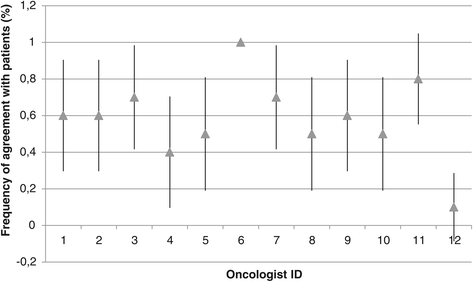Oncologists' perception of depressive symptoms in patients with advanced cancer: accuracy and relational correlates
- PMID: 25815195
- PMCID: PMC4359512
- DOI: 10.1186/s40359-015-0063-6
Oncologists' perception of depressive symptoms in patients with advanced cancer: accuracy and relational correlates
Abstract
Background: Health care providers often inaccurately perceive depression in cancer patients. The principal aim of this study was to examine oncologist-patient agreement on specific depressive symptoms, and to identify potential predictors of accurate detection.
Methods: 201 adult advanced cancer patients (recruited across four French oncology units) and their oncologists (N = 28) reported depressive symptoms with eight core symptoms from the BDI-SF. Various indices of agreement, as well as logistic regression analyses were employed to analyse data.
Results: For individual symptoms, medians for sensitivity and specificity were 33% and 71%, respectively. Sensitivity was lowest for suicidal ideation, self-dislike, guilt, and sense of failure, while specificity was lowest for negative body image, pessimism, and sadness. Indices independent of base rate indicated poor general agreement (median DOR = 1.80; median ICC = .30). This was especially true for symptoms that are more difficult to recognise such as sense of failure, self-dislike and guilt. Depression was detected with a sensitivity of 52% and a specificity of 69%. Distress was detected with a sensitivity of 64% and a specificity of 65%. Logistic regressions identified compassionate care, quality of relationship, and oncologist self-efficacy as predictors of patient-physician agreement, mainly on the less recognisable symptoms.
Conclusions: The results suggest that oncologists have difficulty accurately detecting depressive symptoms. Low levels of accuracy are problematic, considering that oncologists act as an important liaison to psychosocial services. This underlines the importance of using validated screening tests. Simple training focused on psychoeducation and relational skills would also allow for better detection of key depressive symptoms that are difficult to perceive.
Keywords: Cancer; Depression; Oncology; Patient-centered care; Physician-patient relations; Symptom assessment.
Figures


References
-
- Beck AT, Beck RW. Screening depressed patients in family practice: a rapid technique. Postgraduate Medicine. 1972;52:81–85. - PubMed
-
- Boyes A, D’Este C, Carey M, Lecathelinais C, Girgis A. How does the distress thermometer compare to the hospital anxiety and depression scale for detecting possible cases of psychological morbidity among cancer survivors? Supportive Care in Cancer. 2013;21(1):119–127. doi: 10.1007/s00520-012-1499-3. - DOI - PubMed
-
- Chidambaram S, Deshields T, Potter P, Olsen S, Chen L. Patient and provider concordance on symptoms during the oncology outpatient clinic visit. Journal of Community and Supportive Oncology. 2014;12(10):370–377. - PubMed
-
- Cohen J. Statistical power analysis for the behavioral sciences. 2. Hillsdale, New Jersey: Lawrence Erlbaum Associates, Inc.; 1988.
LinkOut - more resources
Full Text Sources
Other Literature Sources

